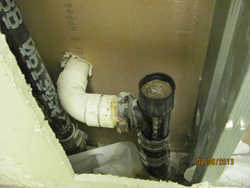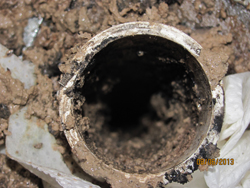
|
| Vol. 21, No. 8 |
September 26, 2013 |
|
|
Waterless Urinals: The Good, The Bad, and The Ugly
|
In recent years, waterless urinals have become a go-to solution for water conservation and "green" restrooms. And why not? On average, it is estimated that a waterless urinal saves 20,000 to 45,000 gallons of water each year1. Proponents claim additional advantages of lower costs, lower maintenance, and a more hygienic restroom environment. Waterless urinals also provide a cost effective means to obtain Leadership in Energy and Environmental Design (LEED) credits - up to 10 percent of the points required for a LEED silver rated building2. When Wetland Studies and Solutions, Inc. (WSSI) constructed the first LEED gold certified facility in Virginia (2005), we incorporated waterless urinals in our men's restrooms. Eight years later, we have had mixed results and are considering switching to the use of conventional urinals using water from our cistern that currently just serves our toilets.
How They Work
 Waterless urinals look and act like conventional urinals; however, do not flush and therefore, do not require the use of water. Waterless urinals use gravity to convey urine to the drainpipe system instead of a flushing system. A sealant liquid is used to trap vapors and odors from the sewer and prevent them from entering the restroom. Most waterless urinals use a trap cartridge that is inserted into the drain opening to hold the sealant liquid and serve as a strainer for unwanted material. This system is also meant to trap uric acid and prevent it from entering the drainage system, as it can crystallize in plumbing and cause backups. Waterless urinals look and act like conventional urinals; however, do not flush and therefore, do not require the use of water. Waterless urinals use gravity to convey urine to the drainpipe system instead of a flushing system. A sealant liquid is used to trap vapors and odors from the sewer and prevent them from entering the restroom. Most waterless urinals use a trap cartridge that is inserted into the drain opening to hold the sealant liquid and serve as a strainer for unwanted material. This system is also meant to trap uric acid and prevent it from entering the drainage system, as it can crystallize in plumbing and cause backups.
The Good
Toilets and urinals account for approximately 50 percent of a typical building's water consumption3. It is generally estimated that waterless urinals save one to three gallons of water per use; therefore, the water conservation implications of waterless urinals are huge. Waterless urinals can also eliminate water loss due to leaking valves or dysfunctional flush components. These water conservation benefits make waterless urinals LEED applicable and often offer the most LEED points with the least amount of cost4 - up to 10 percent of the points required for a silver rated building5. Proponents of waterless urinals also claim secondary benefits such as lower maintenance, cost savings (due to lower maintenance), a more hygienic restroom environment (flushing urinals can spread bacteria through aerosols), and less odor problems (it is the mixing of urine and water that actually causes a foul ammonia smell in restrooms).
The Bad
The state of Virginia and the entire Chesapeake Bay watershed are facing more stringent state and local stormwater regulations that require on-site stormwater management and encourage rainwater harvesting and re-use – waterless urinals may not contribute to meeting these goals. Harvesting rainwater and re-using it for non-potable uses such as flushing toilets and urinals is one way to reduce the load to stormwater collection systems and achieve stormwater volume reduction goals.
At WSSI, our office facilities were designed utilizing Low Impact Development (LID) – a holistic stormwater management strategy that seeks to replicate predevelopment hydrology. Much of the stormwater that enters our site is collected and detained or re-used on-site to the extent that the hydrology of the site mimics that of an undisturbed forest.
Waterless urinals made sense at WSSI initially because we have so many other means to mitigate stormwater runoff. However, sites with less extensive stormwater management could benefit from the re-use of rainwater to supply toilets, urinals, and other non-potable sources and help meet their stormwater reduction goals. In these situations, flushable urinals may be more applicable to help comply with more stringent stormwater regulations. Credit for rainwater harvesting systems is only available for dedicated year-round drawdown/demand for the water6; therefore, providing a consistent source or demand for the water is important to address the water quality treatment volume credit objectives and achieve compliance with the state regulations.
….and The Ugly
Then there is the issue of maintenance. Waterless urinals are not maintenance-free, and while they do not necessarily require more maintenance than a traditional urinal, they do require more oversight than generally touted by their proponents. This is especially true in high traffic restrooms. Cartridges and sealant must be changed, systems must be flushed, and general sanitary measures expected with any restroom facility still need to be adhered to. These steps are not complicated, but may be unfamiliar to maintenance providers. And even after routine maintenance protocols are followed there may still be an issue with backups. This is something that has been an ongoing problem with the waterless urinals at WSSI. Although waterless urinals have a drain trap that is designed to prevent sediment build up (with proper maintenance), some sediment inevitably accumulates in the drainpipe between cartridge replacements. Standard maintenance protocols generally call for water to be poured down the drain after the cartridge is removed for replacement in order to flush soft sediment down the pipe. However, despite following these procedures, we have experienced multiple instances of clogged pipes and backups of our waterless urinals – primarily in two (of four) units. |
 |
 |
| Waterless urinal piping clogged, due to uric acid buildup at WSSI office |
| The issues with clogged pipes have resulted in more maintenance and added costs to repair the system. Fortunately, we were aware of some of the concerns with waterless urinals when our building was designed and installed the infrastructure necessary to switch over to flushable urinals (using our rainwater cistern that serves our toilets) if need be. If this switch is made, it will be easier than retrofitting the plumbing facilities, but still be a considerable added cost.
Lessons Learned
Waterless urinals have the potential to provide water conservation benefits in the right situation. However, the benefits may not always outweigh the drawbacks. Here are some of the lessons we have learned:
1. Application - Waterless urinals may be especially applicable in drought-prone settings where potable water is scarce. They may be less applicable in regions where stormwater management encourages on-site treatment, detention, and water re-use, as flushable urinals may utilize rainwater collected in a cistern or other means to reduce stormwater runoff volumes. Additionally, waterless urinals may not make sense in a high capacity setting since the additional maintenance and oversight can be cost prohibitive.
2. Maintenance - Regular maintenance is imperative for the proper functioning of waterless urinals. Maintenance protocols differ from that of conventional urinals, so maintenance staff should be educated on proper procedures. Even with proper maintenance, we have experienced periodic (roughly once a year on the most used urinal) back-ups.
3. Cost - Waterless urinals have the potential to provide cost savings through reduced water usage fees and infrastructure costs. However, frequent maintenance due to blockage or (worst-case) total replacement due to malfunction, adds to overall costs and may be more expensive than conventional urinals in the long run.
For more information on waterless urinals or WSSI's LID and LEED efforts, please contact Kelly McCutcheon or Mike Rolband.
1Waterless.com, 2011.
2Waterwise Technologies, 2013: Waterless Urinals.
3Bristow, G., J.D. McClure, D. Fisher, 2004. Waterless Urinals: Features, Benefits, and Applications. Proceedings of the Fourteenth Symposium on Improving Building Systems in Hot and Humid Climates, Richardson, TX, May 17-20, 2004.
4Waterless.com, 2011.
5Waterwise Technologies, 2013: Waterless Urinals.
6Virginia DCR Stormwater Design Specification No. 6, Rainwater Harvesting, Version 1.9, March 1, 2011.
|
|
|
|
|
 |
|
|